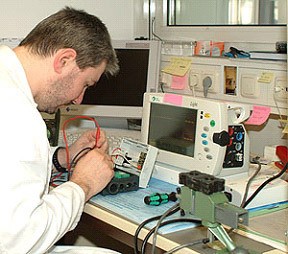Defining Remanufacturing versus Repair
The Next Chapter in the FDA 3rd Party Service Docket
G. Wayne Moore, B.Sc., MBA, FASE
11/13 /18
 At first glance at the title of the upcoming FDA workshop on this topic one may be excused in thinking; “Wait a minute, I thought the FDA has already defined what remanufacturing is!”
At first glance at the title of the upcoming FDA workshop on this topic one may be excused in thinking; “Wait a minute, I thought the FDA has already defined what remanufacturing is!”
FDA definition of remanufacturer: “Any person who processes, conditions, renovates, repackages, restores, or does any other act to a finished device that significantly changes the finished device’s performance, safety specifications, or intended use.” Code of Federal Regulations, Part 820 – Quality System Regulation, Subpart A – General Provisions, Sec. 820.3 Definitions, (w).
Seems straightforward right? But, consider the language in the definition with a bit more circumspection and you may find more confusion than clarity. The first potential landmine in the definition above is determining exactly what constitutes a “significant change”. One can turn to Merriam-Webster in hopes of gaining some insight, but alas we find more non-deterministic synonyms such as – “remarkably”, “crucially”, “importantly”, and “materially”. I did find some hope, and potentially direction, in the word “importantly” as it might apply to a finish medical device. I will explore that vector later in this newsletter. One last point on the phrase “significant change”, please notice it does not specify in which direction the change occurs. I have heard some fairly self-serving comments from a few of the after-market service companies such as; “Better than the OEM”, “Meet or exceed the OEM specifications”, and so on. Totally absurd comments and likely to put them at odds with the FDA. Change is change – if your body temperature drops by 10%, you’re dead. If it goes up by 10%, you’re dead. If an OEM specifies a transmit voltage level to excite the crystals in their ultrasound probe and you reduce it by 10%, you have worse clinical performance. If you increase it by 10%, you may be in violation of the FDA limits on acoustic power. Remember the definition of servicing is: the restoration of the device to OEM specifications, not making it “better”. With that in mind, let’s take a specific look at the FDA definition above and how one could go about determining what their “repair” activities really may be.
In the definition above the FDA focuses on three specific areas; (1) performance, (2) safety, and (3) intended use of the finished medical device. If a servicer wants to know what the FDA may have in mind regarding these three areas one need only look at the FDA’s guidance documents for pre-market clearance for a given device. These guidance documents (available free for download on the FDA’s website) describe what is required from the OEM for its 510(k) submission, and for our discussion here will shine a light on what may be remanufacturing versus repair. By way of example, I will briefly describe what is required for 510(k) clearance of diagnostic ultrasound devices. Even more specifically, I will describe what is required for an ultrasound probe – after all the FDA considers an ultrasound probe a Class II (with special controls) finished medical device. For an OEM to gain 510(k) clearance for a probe it must objectively demonstrate through testing that it meets the requirements of specific conformance standards, for example three key standards are (not an exhaustive list): IEC60601-1 (General Electrical Safety), IEC60601-2-37 (Acoustic Output Power and Intensity), and IEC 10993 (Material Biocompatibility). Any changes to the OEM validated and FDA cleared ultrasound probes that impact one or more of these standards, must at a minimum undergo re-testing and rigorous engineering evaluation to objectively demonstrate that the changes made by the “servicer” produce results that are substantially equivalent to the OEM’s, if they do – that may be considered servicing. If they don’t then you are likely meeting the definition of remanufacturing and you must be registered with the FDA and file for a new 510(k) for the device you remanufactured.
I am looking forward to attending and contributing to the upcoming FDA workshop and see where this issue might be heading in terms of regulating 3rd Party Servicers in this market. I will be showing specific examples of probe repairs that cross that line.
Until next month,
Wayne
About the Author, G. Wayne Moore:
A 30-year veteran of the diagnostic ultrasound market Wayne has held senior level positions with several major medical equipment manufacturers, including Honeywell Medical Systems and Siemens Medical Solutions. Wayne has been directly involved in the development and commercialization of more than 15 technologically intensive ultrasound systems. He is widely published in diagnostic ultrasound literature, a sought after speaker at medical imaging conferences, has served as an expert witness in multiple ultrasound litigations, and holds more than 16 United States ultrasound related patents. Wayne obtained his MBA from the University of Denver – Daniels College of Business.
He was elected as a Fellow of the American Society of Echocardiography (FASE) in 2009.
Acertara Labs
Correspondence: Dave Dallaire
1900 South Sunset Street, Suite F, Longmont, CO 80501, USA
Email: [email protected]
www.acertaralabs.com
